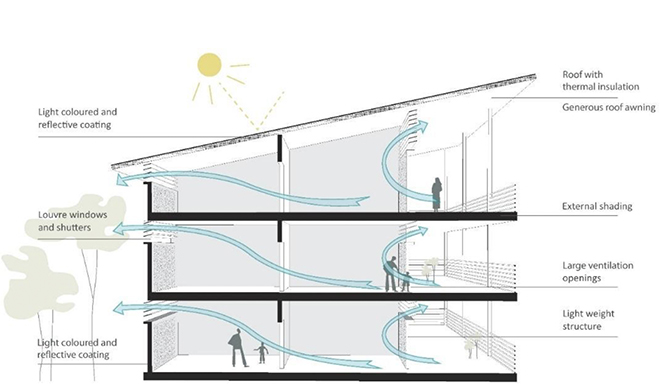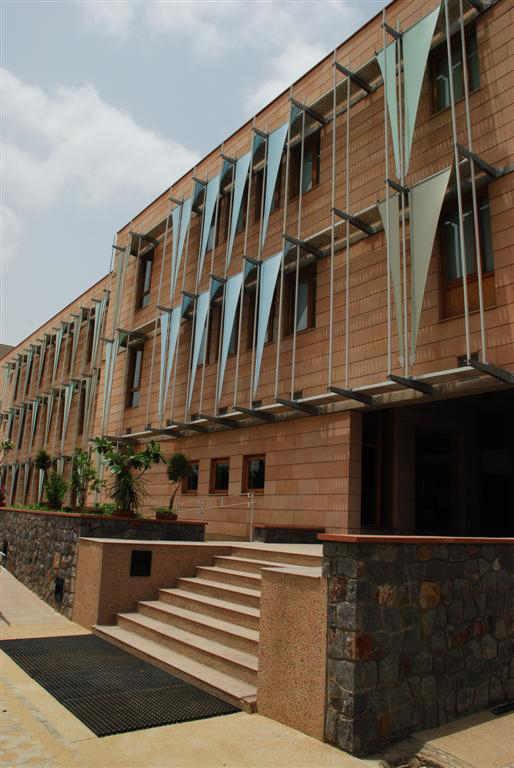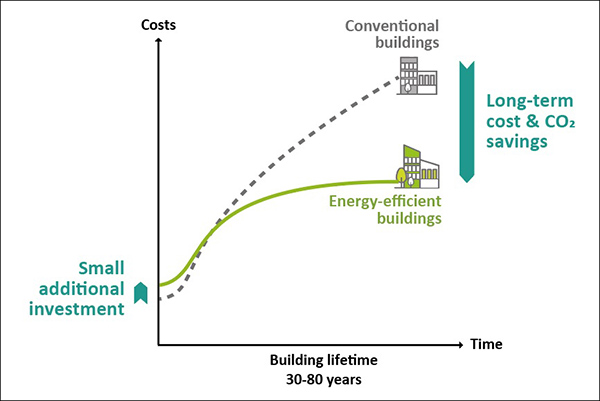It’s getting hot: sales of ACs are skyrocketing to keep buildings cool
We need “cool buildings” if we want to meet the needs for cooling and fight global warming. Energy needs for space cooling could triple by 2050, especially in hot and tropical countries. Residential buildings are responsible for over two thirds of this increase. Global sales of air conditioning (AC) systems per year have nearly quadrupled since 1990. 2.8 billion people live in places with average daily temperatures above 25°C all year; yet, only 8% of them have an AC. This trend is set to continue and intensify, driven by rising incomes, the expected doubling of building floor area by 2060, and a warming planet with higher temperatures and more frequent heatwaves.
Buildings are often the problem – but can be the solution
Today, around the globe, malls, offices and residential buildings are being constructed at a breath-taking speed. They often follow standard designs that are not adapted to the climate, using steel, concrete and glass. Poorly designed buildings overheat. To provide thermal comfort, they need an excessive amount of energy for mechanical cooling. This leads to a state of “air-conditioned discomfort” (Ashok Lall), a phenomenon that has also been called the air-conditioning trap.
Changing how we design buildings can be the solution: “Cool buildings” are designed with knowledge about the local climatic conditions, and adapt smartly to their environment. Before the advent of electricity, buildings in hot climates had to stay cool by adapting to the climate. They achieved comfortable living conditions by using long roof overhangs, heavy walls or light structures, natural ventilation, exterior shading, green courtyards and urban design. “Cool buildings” use both old and new strategies to produce comfortable and healthy living and working conditions. They can limit the massive growth in energy needs for cooling, save money and reduce energy poverty

Graph: PEEB, Better design for cool buildings
Better design for cool buildings – adapt to the climate instead of fighting it
We have the strategies at our disposal to provide comfortable living conditions without harming the climate. The approach of “avoid-shift-improve” which was first used in the transport sector sets out a clear hierarchy of action: “Cool buildings” with building design adapted to the climate are the essential step, as they can avoid unnecessary demand for energy for cooling.
For the remaining cooling needs, e.g. temperature peaks, or in buildings with special cooling needs, we need to shift the modalities of providing the service to more climate-friendly ways, like solar systems or district cooling, and lastly improve the efficiency of conventional systems and appliances, such as air-conditioners.
“Cool buildings” are not rocket science. If buildings are adapted to the local climate and use passive cooling techniques, they can keep cool naturally. Variations depend on the climate zone, the local building culture and building use. Simple measures can massively bring down the demand for mechanical cooling. Climate-adapted building envelopes, light colours for facades and roofs, windows, natural ventilation, orientation and vegetation offer large possibilities to reduce the energy demand for cooling.

Better building designs can be highly cost-efficient. The design stage is crucial, when extra effort is minimal to make significant changes. Better designed buildings also help protect vulnerable people from the effects of extreme heat, a key goal of the Cool Coalition.
Finally, we must look beyond the single building and factor in urban planning and design – the urban form can hugely reduce cooling demand as well.

Graph: PEEB Status 2020
Strategies for cool buildings – how can we accelerate the uptake of green buildings?
A webinar on cool buildings organised by the Cool Coalition, the GlobalABC, PEEB and SEforALL presented strategies for how buildings can curb the rise in cooling demand. The message was clear: cooling in buildings is a hot topic, and the solutions are there.
Participants presented solutions from across the globe, ranging from energy-efficient and comfortable social housing in India, to the development of the first voluntary Building Energy Efficiency Code (BEEC) in Nigeria, and pointed to the need for good urban planning. The panel agreed that technology is not the issue: there is a wealth of old and new building techniques that can be easily applied, often at low cost, with benefits not only for energy and cost savings, but also health, resilience and quality of life.
International action on the road to COP26
The big question is how do we get there? We have the elements in place, but we need more action to accelerate the uptake of green buildings. Policies are critical in this respect: from building codes, financial incentive programmes for green buildings, non-financial incentives such as fast-track permitting for green buildings, to urban planning. Policies that are co-created with the private sector, for example through national alliances, and communicated widely, increase the demand for better designed buildings. We need to accelerate the uptake of green buildings and enable a supply chain of solutions for cooling that encompass both building design and efficient technologies. Several campaigns have been launched to highlight this issue. GlobalABC is an umbrella platform that brings together governments with the private sector and other actors throughout the buildings and construction value chain. SEforALL is rallying support for Cooling for All, and is tracking progress on cooling with the Chilling Prospects report and launching a solutions-driven communications campaign #ThisIsCool. The Cool Coalition works as a global multi-stakeholder network to highlight the issues of climate-friendly cooling. The Programme for Energy Efficiency in Buildings (PEEB) combines financing for energy efficiency in large-scale building projects with technical assistance and is catalysed by GlobalABC.
On the road to the next climate change conference COP26 in November 2021, we need to bring “cool buildings” to the forefront to stay cool and keep the planet from heating up.
This article was authored by Brian Dean, Lead, Energy Efficiency and Cooling, SEforALL; Christiana Hageneder, Head of Secretariat, Programme for Energy Efficiency in Buildings (PEEB); and Martina Otto, Head, Cities Unit, United Nations Environment Programme.